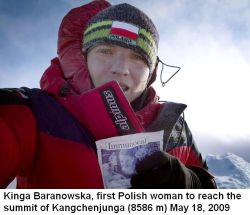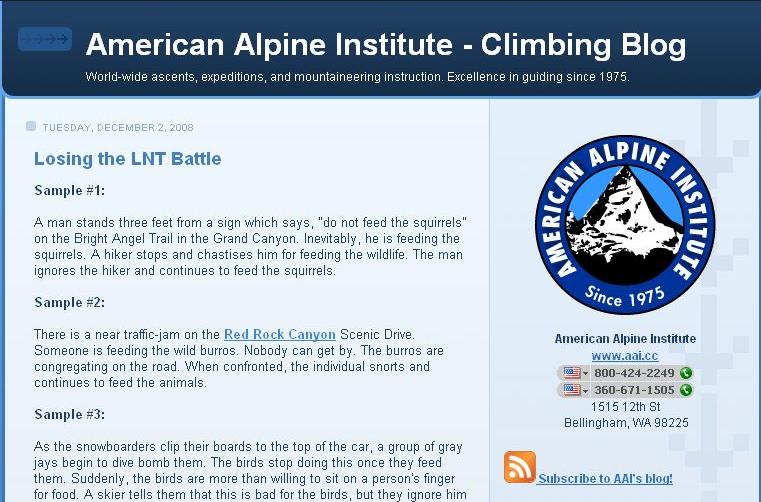And it’s great that it was achieved by Poles. Jurek Werteresiewicz drew up a programme, Andrzej Zawada implemented it and many of us put it into practice, often successfully but there were failures as well.
In recent years a total withdrawal from wintertime climbing could be observed in the Tatras, the Alps as well as the Himalayas. The late Andrzej Zawada would remark: “Tell me what you’ve done and I’ll tell you who you are (that is to say, what you're worth). Winter experiences were valuable, however. Meanwhile the standards have been lowered by the rat-race to easy and quick successes (which actually has been the case in every field).
No-one dreams of climbing the great walls of the Himalayas, of new routes, traverses… The attitude is to climb Mt. Everest if you have cash and if not, another easy 8000-metre mountain, as long as it’s fast and easy. When, after many years, I met Elisabeth Hawley in Katmandu in January this year, we began reminiscing the 1970s and 1980s, when the Japanese, Poles, Englishmen, Frenchmen, Russians and the Slovenians would come with sports programmes, in order to compete with the others, to reach places that had not been reached so far, to go down in the history of conquests of the highest mountains. There is the same number of expeditions as before but they lack ambitions goals. The ambitious ones can be counted on the fingers of one hand. Generally, there is a fad for easy and pleasant climbing, preferably at weekends because it does not require sacrificing your time or career. It has to be fun. It has to be cool.
As for our Polish scene, the Sports Committees, if they exist at all, lack creativity. Committees and boards tend to accept programmes aimed at a quick, usually personal success of the Himalayan climbers that God still keeps alive. I realize that we live in times when each success has to be associated with a name, with individuals who easily lend themselves to the requirements of the media. But why is it a problem to proclaim: “Poles have climbed Sisha Pangma or K-2 in winter"?
According to the old rule, you should do what you do best. We were successful in high mountain winter explorations. After all, half of fourteen 8000-metre peaks were climbed by Poles, within just eight years (1980-1988) to boot. Six unconquered peaks are waiting for us, but volunteers are nowhere to be seen.
Let the nickname “Ice Warriors”, given us by Englishmen, be inscribed in the history of Himalayan climbing for ever.
We missed out on the great exploration of the Himalayas irreversibly, and it is more and more difficult to find new (logical) routes. We could still improve our style, and we could revive the best moments of wintertime experiences. I know that for some people wintertime climbing is “the art of suffering” but I also know that for others it is a male adventure, with teamwork, the rule "one for all and all for one", brotherhood and common goals. Those who have experienced that do not need to be convinced, whereas the majority of adversaries of wintertime Himalayan climbing can be found among those who simply have not tried it or are unable to work in a team, are afraid to lose their “libero” position, afraid of a violation of their individuality. We are going separate ways! We have done one half of the job. Now it’s your turn to finish it: you the young, angry and ambitious. We are giving you eight years, the same time as we needed. It’s fair enough, isn’t it? If you could pull it off, wouldn’t it be great? Can you imagine that? All 8000-metre peaks conquered for the first time in Winter, all by Poles. There is a chance for success. It is a game worth devoting time, money and efforts. Now is the time to make decisions. This proposal is addressed to the Polish Mountaineering Association: how to create the right environment, how to make “the young” interested in this idea? You may count on my generation, on our help, our experience, even our active participation. The choice is yours! If you do not take up the challenge, we shall have to take it on our old shoulders, without a guarantee of success. K-2, Makalu, Nanga Parbat, Gasherbrum I and Gasherbrum II, Broad Peak are waiting for you (or us).
Let’s join Europe, with our head held high and with self-esteem. There is little time left!
*Manifesto on 2002 r - Polski Związk Alpinizmu
2007 Winter Nanga Parbat: It’s over - http://www.mounteverest.net/news.php?id=15523
Pierwsze wejścia
| Lp. | Nazwa | Wysokość | Data zdobycia | Pierwsi zdobywcy | Pierwsi zdobywcy | |
| 1 | ok. 8850 | 29 maja 1953 | Edmund Hillary | 17 lutego 1980 | ||
| 2 | 8611 | 31 lipca 1954 | Achille Compagnoni i | niezdobyty zimą | ||
| 3 | 8586 | 25 maja 1955 | George Band i | 11 stycznia 1986 | Jerzy Kukuczka | |
| 4 | 8516 | 18 maja 1956 | Fritz Luchsinger i | 31 grudnia 1988 | Krzysztof Wielicki | |
| 5 | 8463 | 15 maja 1955 | Lionel Terray | niezdobyty zimą | ||
| 6 | 8201 | 19 października 1954 | Sepp Joechler i | 12 lutego 1985 | Maciej Berbeka | |
| 7 | 8167 | 13 maja 1960 | Kurt Diemberger | 21 stycznia 1985 | Andrzej Czok | |
| 8 | 8156 | 9 maja 1956 | Toshio Imanishi (Japonia | 12 stycznia 1984 | Maciej Berbeka i | |
| 9 | 8126 | 3 lipca 1953 | Hermann Buhl (Austria) | niezdobyty zimą | ||
| 10 | 8091 | 3 czerwca 1950 | Maurice Herzog | 3 lutego 1987 | Artur Hajzer | |
| 11 | 8068 | 4 lipca 1958 | Andy Kauffman i | niezdobyty zimą | ||
| 12 | 8047 | 9 czerwca 1957 | Hermann Buhl, | niezdobyty zimą | ||
| 13 | 8035 | 7 lipca 1956 | Sepp Larch, | niezdobyty zimą | ||
| 14 | 8013 | 2 maja 1964 | Hsu Ching (Chiny) | 14 stycznia 2005 | Piotr Morawski |
 Złota dekada polskiego himalaizmu prócz niepodważalnych osobistych wyników Jurka Kukuczki, Wandy Rutkiewicz, Wojtka Kurtyki i innych to równieżnasze zimowe dokonania, które były bardziej sukcesem grupowym niż indywidualnym. To na wyprawach zimowych szczególnie było widoczne , jak zespół pracował na wynik. Trudno jest zimą osiągnąć sukces jednostce bez pomocy zespołu. Wspinanie w porze zimowej w Alpach czy Tatrach nikogo już nie dziwi: było naturalną koleją rzeczy , próbą podniesienia poprzeczki bez zwiększania wysokości. To musiało się stać i w wgórach wysokich.
Złota dekada polskiego himalaizmu prócz niepodważalnych osobistych wyników Jurka Kukuczki, Wandy Rutkiewicz, Wojtka Kurtyki i innych to równieżnasze zimowe dokonania, które były bardziej sukcesem grupowym niż indywidualnym. To na wyprawach zimowych szczególnie było widoczne , jak zespół pracował na wynik. Trudno jest zimą osiągnąć sukces jednostce bez pomocy zespołu. Wspinanie w porze zimowej w Alpach czy Tatrach nikogo już nie dziwi: było naturalną koleją rzeczy , próbą podniesienia poprzeczki bez zwiększania wysokości. To musiało się stać i w wgórach wysokich.
Dobrze, że stało się to za sprawą Polaków. Jurek Werteresiewicz nakreślił program, Andrzej Zawada wprowadził go w życie, a wielu z nas go realizowało, często nawet z powodzeniem, chociaż były i porażki.
Wostatnich latach można zauważyć całkowity odwrót od wspinania się zimą. Dotyczy to Tatr, Alp, a także Himalajów. Ś.p. Andrzej Zawada zwykł mówić: "Powiedz mi, co zrobiłeś zimą w Tatrach, a powiem ci kim jesteś ( czytaj , ile jesteś wart). Doświadczenia zimowe były jednak w cenie.Tymczasem wraz z owczym pędem do szybkiego sukcesu ( na każdym zresztą polu), obniżono poprzeczkę. Już nie marzy się o przejściu wielkich ścian Himalajów, o nowych drogach, o trawersach.
Myśli się, aby wejść na Mt. Everest, jeśli ma się kasę, a jeśli nie , to na jakiś łatwy ośmiotysięcznik, byle szybko, byle łatwo. W styczniu tego roku, gdy po latach spotkałem się z panią Elisabeth Hawley w Katmandu, zaczęliśmy wspominać lata 70.i 80.,kiedy to przyjeżdżali Japończycy, Polacy, Anglicy, Francuzi, Rosjanie, Słoweńcy ze sportowymi programami, by rywalizować z innymi, zdobywać, co jeszcze nie zdobyte, zapisać się w historii podboju gór najwyższych. Wypraw przybywa tyle samo, ale ambitnych celów już nie. Można je policzyć na palcach jednej ręki. W ogóle nadeszła moda na wspinanie łatwe, przyjemne, najlepiej weekendowe, bo nie wymaga poświęcenia czasu lub kariery. Po prostu "for fun" i by było " cool".....Rozumiem teraz takie czasy, że każdy sukces musi być kojarzony z nazwiskiem, osobą, że to dobrze podaje się wymogom medialnym, ale co stoi na przeszkodzie, by znów mówiono: Polacy weszli zimą na Sisha Pangma czy na K-2!
Stara zasada mówi, że powinno się robić to , co nam dobrze wychodzi. Dobrze zapisaliśmy się w zimowej eksploracji w górach wysokich. W końcu z czternastu szczytów ośmiotysięcznych połowę zdobyli Polacy i to w ciągu zaledwie ośmiu lat (1980 -1988). Jeszcze sześćszczytów czeka na nas, są dziewicze, a chętnych nie widać.
Niech przydomek " Ice Warriors", nadany nam przez Anglików, na stałe zapisze się w historii himalaizmu.
.. My zdobyliśmy połowę. Teraz kolej na Was: młodych, gniewnych , ambitnych. Dajemy Wam też osiem lat, tyle , ile nam było potrzeba. To chyba fair ? To byłaby sprawa, możecie sobie wyobrazić? Wszystkie szczyty ośmiotysięczne zdobyte po raz pierwszy zimą, wszystkie przez Polaków. Jest taka szansa, to jest gra warta poświęcenia czasu, sił, środków. To czas na decyzje. To propozycja pod adresem PZA, jak stworzyć warunki, jak zainteresować "młodych" taką ideą? Ze strony mojego pokolenia możecie otrzymać pomoc, doświadczenie, nawet aktywne uczestnictwo. Wybór należy do Was! Bo jeśli nie, to ...my zmuszeni będziemy wziąć to na swoje barki, już stare i nie gwarantujące, że cel osiągniemy. Przed Wami ( lub przed nami) K-2, Makalu, Nanga Parbat, Gasherbrum I i Gasherbrum II , Broad Peak.
*Manifest został odczytany w 2002 roku na zjeździe Polskiego Związku Alpinizmu






















































